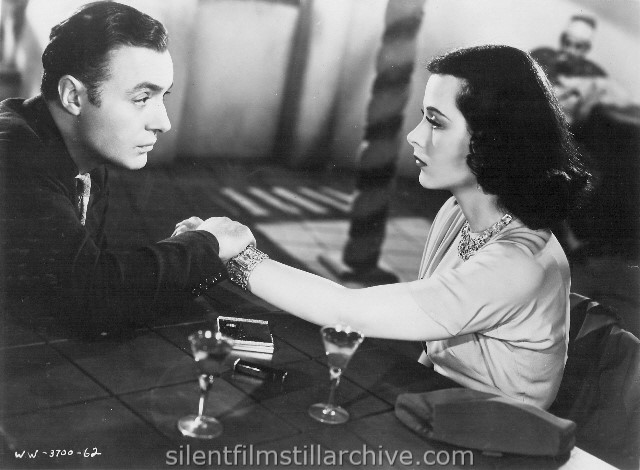Atmosphere, intrigue, romance, and suspense are all in
a day’s work for France’s most notorious jewel thief, Pepe Le Moko. In the
classic romantic thriller Algiers, Pepe’s
exploits showed audiences just how right it could feel to be on the wrong side
of the law. Released in 1938, the film is one of the earliest examples of the
emerging film noir genre, which highlighted the isolation, paranoia, and
existential ennui of modern life, even in the midst of the exotic underworld of
the Algerian capital.
 |
| A bad boy with a heart of 14 karat gold to be exact |
The story begins with police tracking Pepe (Charles
Boyer) in the most recent in a long line of unsuccessful sting efforts. Recently
arrived Commissioner Janvier (Paul Harvey) is humiliated when his strong-arm
techniques fail and scoffs as veteran officer Inspector Slimane (Joseph
Calleia) continues to maintain a strangely amiable game of cat and mouse with
the elusive thief. As his criminal associates celebrate their latest success
against the local authorities, however, Pepe remains aloof. It is then revealed
that despite his latest victory against the authorities Pepe is in fact already
a prisoner, albeit in a cell of his own making. Regardless of however many
victories he may have against local inspectors, he is all too aware that should
he leave the native quarter known as the Casbah he will find himself at the
mercy of the full force of the French police, whom even he can’t elude forever.
After years resigned to his fate he meets the alluring French tourist, Gaby
(Hedy Lamarr), who is similarly trapped by her own efforts to enter high
society through an impending loveless marriage. Invigorated by the first
genuine connection that either of the mercenary duo have felt Pepe and Gaby
hatch a plan to escape not just the Casbah but the lives of quiet desperation
that they have resigned themselves to, no matter what the cost.
While at first glance Algiers appears to be just
another exotic romantic drama, upon closer observation the film is revealed to
be an innovative catalyst in Hollywood filmmaking. Perhaps best remembered
today for inspiring amorous cartoon skunk Pepe Le Pew, the remake of the French
hit Pepe Le Moko was one of America’s
first efforts to integrate European techniques since the use of German Expressionism
during the silent era. With its claustrophobic settings, murky morals, and
existential outlook, the film introduced the philosophical and social themes prominent
in European films, while still maintaining the cleverly entertaining guise of a
romantic adventure. The film also successfully merged American and European
cinema through its gritty focus upon the criminal lifestyle reminiscent of the
American gangster film, while still maintaining its core European sensibility. Although
produced four years after the enforcement of the Hays Code, the film managed to
lend viewers a frank look at modern sexuality through its portrayals of Pepe’s relationships
with both local beauty Ines (Sigrid Gurie) and kept woman Gaby, without
condescending to pass judgment on its complicated cast of characters. The film
also offered a starkly modern finale in an interesting twist on the typical
crime film by presenting Pepe’s tragic end not as an example of the ways in
which ‘crime doesn’t pay’, but instead as the ultimate form of freedom. The
film featured breakout performances for both Charles Boyer and Hedy Lamarr (who
made her Hollywood debut in her role as Gaby) and went on to inspire a host of
thinly veiled imitations, including the now classic Casablanca. In fact, it is reported that when screenwriters Philip
and Julius Epstein persuaded producer David O Selznick to loan out Ingrid
Bergman’s contract to Warner Brothers for the role of Ilsa, they only succeeded
after describing Casablanca as “A lot
of s*** like Algiers”.
.jpg) |
| It's all about the bling |
Although a faithful remake of Pepe Le Moko, Algiers
became a classic in its own right through its truly star-making performances. Joseph
Calleia exudes a fascinating combination of world weariness and sly charm in
his role as Pepe’s greatest ally and most dangerous foe, Inspector Slimane.
Sigrid Gurie takes what could have been a one-note role as Pepe’s scorned
mistress and transforms Ines into a truly complicated woman who is at once the
epitome of worldly sensuality and the picture of damaged vulnerability. Hedy
Lamarr is luminous in her role as the elusive Gaby, aptly capturing both Gaby’s
ambition and desperation while still maintaining a sophisticated façade. In the
scenes that she shares with Boyer she perfectly embodies the playful excitement
and anxious hesitance of new love with such nuance that it is little wonder that
she quickly became a household name. Despite the multi-faceted performances
surrounding him, the film truly belongs to Charles Boyer, whose charismatic
anti-hero is at once a Robin Hood-esque rogue and a tragic figure. While Boyer
himself felt that his performance paled in comparison to Jean Gabin’s, modern
audiences continue to hear the name Pepe Le Moko and immediately picture
Charles Boyer, and with good reason.
At once a captivating tale of romance and adventure
and a psychological study of a life on the run, Algiers is a classic film with a modern edge. Through its clever
dialogue, layered characterizations, and entrancing atmosphere Algiers is a journey into the good old,
bad old days which audiences continue to return to. So what are you waiting
for, follow Charles Boyer and Hedy Lamarr into the labyrinth of mystery, intrigue,
and passion that is Pepe’s Casbah.
 |
| A jewel thief's greatest match; a gold-digger |



